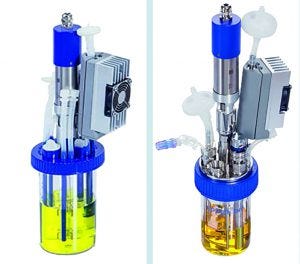- Sponsored Content
Small Scale Escherichia Coli Cultivation Using BioBLU Single-Use and Reusable Vessels: A Comparative StudySmall Scale Escherichia Coli Cultivation Using BioBLU Single-Use and Reusable Vessels: A Comparative Study
Sponsored by Eppendorf
 In recent years, single-use bioreactors have gained more importance in animal and human cell culture. With its new line of BioBLU frigid-wall, stirred-tank, single-use vessels, Eppendorf offers premium solutions for microbial applications. In the following case study, reproducible process control was achieved with parallel-operated BioBLU 0.3f single-use and reusable glass vessels, both used in an Eppendorf DASbox® mini bioreactor system. Fermentation of Escherichia coli K12 led to very comparable results, thus proving tested single-use vessels to be an appropriate tool to accelerate microbial process development and shorten time-to-market in all industries related to microbial production processes.
In recent years, single-use bioreactors have gained more importance in animal and human cell culture. With its new line of BioBLU frigid-wall, stirred-tank, single-use vessels, Eppendorf offers premium solutions for microbial applications. In the following case study, reproducible process control was achieved with parallel-operated BioBLU 0.3f single-use and reusable glass vessels, both used in an Eppendorf DASbox® mini bioreactor system. Fermentation of Escherichia coli K12 led to very comparable results, thus proving tested single-use vessels to be an appropriate tool to accelerate microbial process development and shorten time-to-market in all industries related to microbial production processes.

BioBLU of 0.3f single-use vessel (left) and DASbox mini bioreactor (right)
IntroductIon
Single-use bioreactors are a suitable tool for time- and cost-effective bioprocessing. Minimized setup times, eliminated cleaning procedures, and reduced labor time can sustainably accelerate bioprocess development. In all biopharmaceutical industries, single-use technologies are widely used in mammalian cell culture. With the new BioBLU f line that are specifically designed to meet the needs of fermentation, single-use bioreactors make their way to microbial applications in biopharmaceuticals, food, and cosmetics industries.
Microbial applications make specific demands on bioreactor design and functionality. Fermentation processes need much higher kLa values for proper mass transfer as well as suitable heating and cooling options. This comparative study investigates the functionality and reliability of a BioBLU 0.3f single-use mini bioreactor and an autoclavable DASbox mini bioreactor in small-scale E. coli fermentation.
Results and Discussion
Highly reproducible OTR values of up to 250 mmol/L/h were observed in the single-use and glass bioreactors. Supporting kLa values ≤2,500 h–1 were determined by static sulfite depletion method, thus demonstrating that the single-use design of the BioBLU 0.3f bioreactors perfectly matches the demands of microbial applications. The biomass production was determined offline as cell wet weight and revealed comparable growth characteristics in single-use and glass mini bioreactors. The maximal biomasses of about 160 g/L achieved in the fermentation are equal to an OD600 of about 100 (data not shown).
Conclusion
This case study proves the BioBLU 0.3f single-use bioreactor addresses the specific needs of an E. coli fermentation, especially in regard to mass and heat transfer. OTR values (measured in the single-use vessel process runs) and the final biomasses achieved were comparable with those achieved with conventional autoclavable DASbox glass bioreactors. The specifically adapted single-use design of the BioBLU 0.3f mini bioreactor supports the high demands of microbial applications. Used with the Eppendorf DASbox bioreactor, the BioBLU 0.3f single-use bioreactor is a premium tool for screening and media optimization as well as a scale-down model for process development including design of experiments (DoE) approaches. With the BioBLU f line of single-use vessels, Eppendorf is offering premium solutions for microbial applications. Users in fermentation can now benefit from advanced process control, accelerated process development, reduced costs, and shorter time-to-market.
Claudia M Huether-Franken, Christiane Schlottbom, and Sebastian Kleebank are bioprocess managers,102 Motor Parkway, Hauppauge, NY, 11788 ;1-800-645-3050; fax:1-516-334-7506. Extended study is available at eppendorf.com or by contacting [email protected].
You May Also Like






